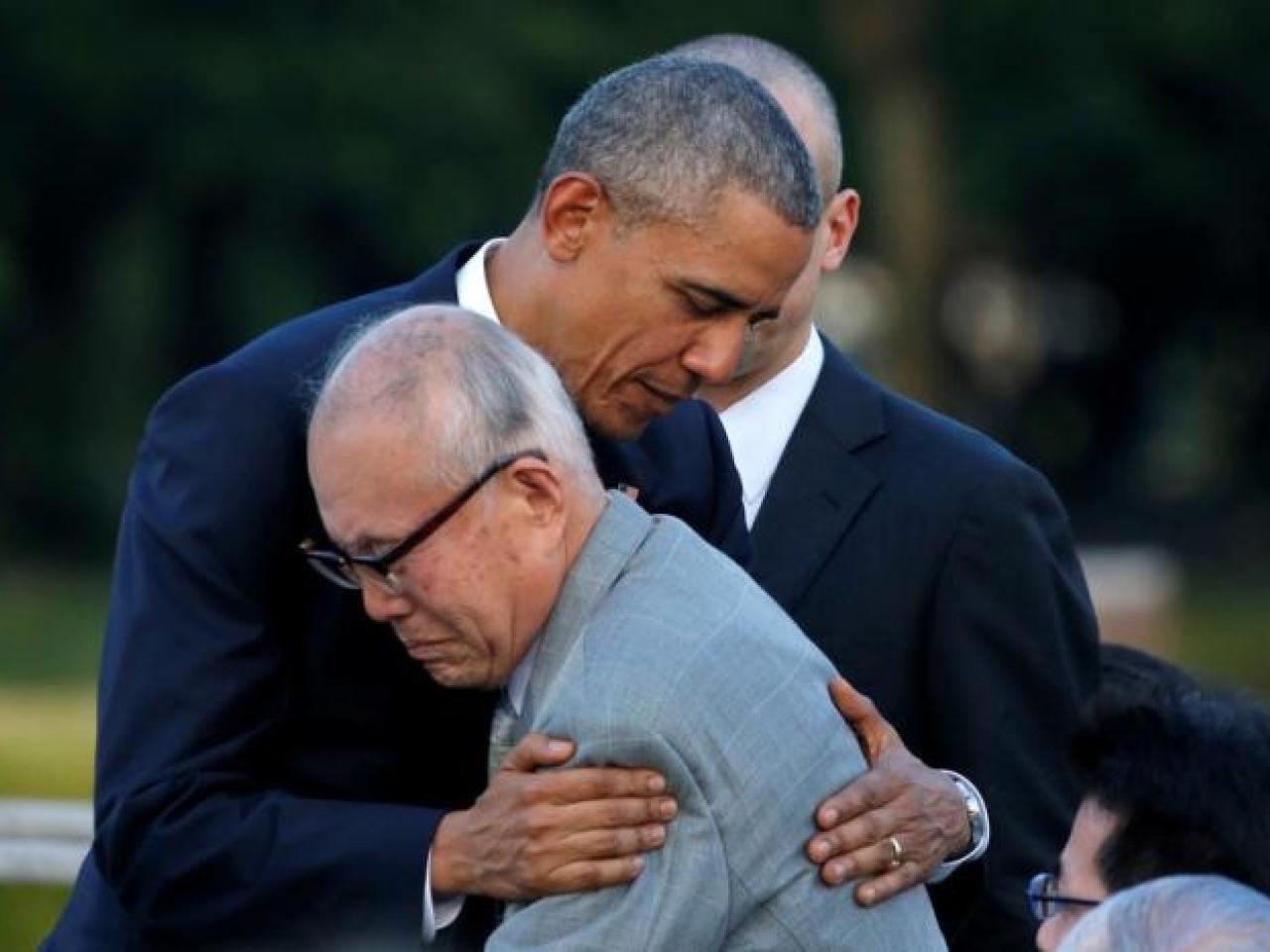Lessons of the Nuclear Age

President Obama with atomic bomb survivor Shigeaki Mori.
August 6 and 9 mark the anniversary of the Hiroshima and Nagasaki atomic bombings. New Day filmmaker Bob Richter shares his thoughts on the continuing legacy of these attacks.
This past May, I was deeply moved to see President Barack Obama embrace a 91-year-old survivor of the nuclear attack in Hiroshima. The scene of the survivor with the President brought back powerful memories about the city’s attack—the first time an atomic bomb was used to destroy people. It was only a few years ago that my co-producer Kathleen Sullivan and I had joined survivors in Nagasaki, where the second and last atomic bomb was dropped. Thousands of residents, government officials, and religious leaders gathered collectively to remember what happened in that city at 11:02 a.m. on August 9, 1945.
At an exhibit at the Nagasaki Atomic Bomb Museum, where a Japanese-language version of our documentary The Ultimate Wish: Ending the Nuclear Age had premiered a few days earlier, we viewed mangled clocks frozen at that precise moment. The temperature during the commemoration was so fiercely hot that we draped our necks with ice-cold cloths that had been passed around the large outdoor tent where we were sitting. Hardly worth complaining about, as the temperature from the detonated bomb was several thousand degrees, instantly incinerating an estimated 70,000 men, women, and children. A bell tolled at 11:02 a.m. at the Peace Park—Nagasaki’s Ground Zero—and we stood silently to pay tribute to the moment that forever changed history.
I met many atomic bomb survivors while Kathleen and I were producing The Ultimate Wish: Ending the Nuclear Age. Our film finally came to settle on the remarkable testimony and life of Sakue Shimohira, who at the age of ten was left to hide in a Nagasaki shelter when the bomb dropped. In one of the film’s most powerful moments, Sakue describes her sister’s suicide ten years after the end of World War II. While her sister found "the courage to die," Shimohira-san found "the courage to live" and has since dedicated her life to abolishing nuclear weapons.
We follow her in the company of two Japanese students as they talk with students in London, New York and Nagasaki. We also see her in a gripping encounter with a Holocaust survivor.
Our film strives to cast new light on events that are too easily relegated to a tragic segment of history. We show how there were US military leaders that challenged the belief that Nagasaki was essential for military victory—a prevailing belief that even I had bought into before the making of the film. Through a highly regarded Japanese journalist, we learn about the Press Code imposed by the U.S. occupation government, that for years prohibited him and other members of Japan’s media from reporting on the bomb or its health effects. And we also touch upon the Atomic Bomb Casualty Commission, a U.S. agency that gathered data from thousands of survivors and sent that data to the U.S.—not Japan—and did not attempt to ameliorate the health problems of the survivors.
Other films in the New Day collection also touch upon the costs of living in a nuclear age. In the Academy Award-winning documentary Deadly Deception, filmmaker Deborah Chasnoff juxtaposes GE's rosy "We Bring Good Things To Life" commercials with true stories of workers and neighbors whose lives have been devastated by GE’s involvement in building nuclear bombs. It tells a powerful story of how consumer activists can challenge corporations causing harm.
In How To Prevent A Nuclear War, Liane Brandon takes a refreshingly upbeat and compelling look at the kinds of activities that Americans engage in to lessen the threat of nuclear war, whether it be visiting their local representative or starting a Concert for Peace. It is a film about grassroots democracy in action, featuring unforgettable vignettes of people working for peace in their communities.
In our film The Ultimate Wish, a nuclear expert explains that there is a strong, but rarely mentioned, link between nuclear weaponry and nuclear power, and we briefly document the burgeoning movements to end both. One of our characters Takako Shishido, who was living in Fukushima at the time of the March 2011 nuclear power plants’ triple meltdowns, tells us what happened and what she would like to see happen now.
Filmmaker Suzan Beraza similarly takes a look at the impact of using nuclear energy in America in her critically acclaimed documentary Uranium Drive-In. The film follows a proposed uranium mill in Colorado—the first to be built in the U.S. in 30 years—and the debate pitting a population desperate for jobs and financial stability against an environmental group based in a nearby resort town. Without judgment, both sides of the issue are brought to life in heart-wrenching detail as the film follows conflicting visions for the future. The film offers no easy answers but aims instead to capture personal stories and paint a portrait of the lives behind this nuanced and complex issue.
I have made several different films covering nuclear issues since the 1970s and the threats are still very much with us. Today, nine countries in the world possess at least a total of 15,375 nuclear weapons, each many times more destructive than the two used at Hiroshima and Nagasaki. The United States seeks to monitor and decrease nuclear arms in other countries, as it simultaneously works to modernize its own stockpile. While new vital concerns justifiably dominate our media headlines, learning and remembering nuclear history is fundamental to our existence. We cannot ignore the voices demanding the ultimate wish: ending the nuclear age.